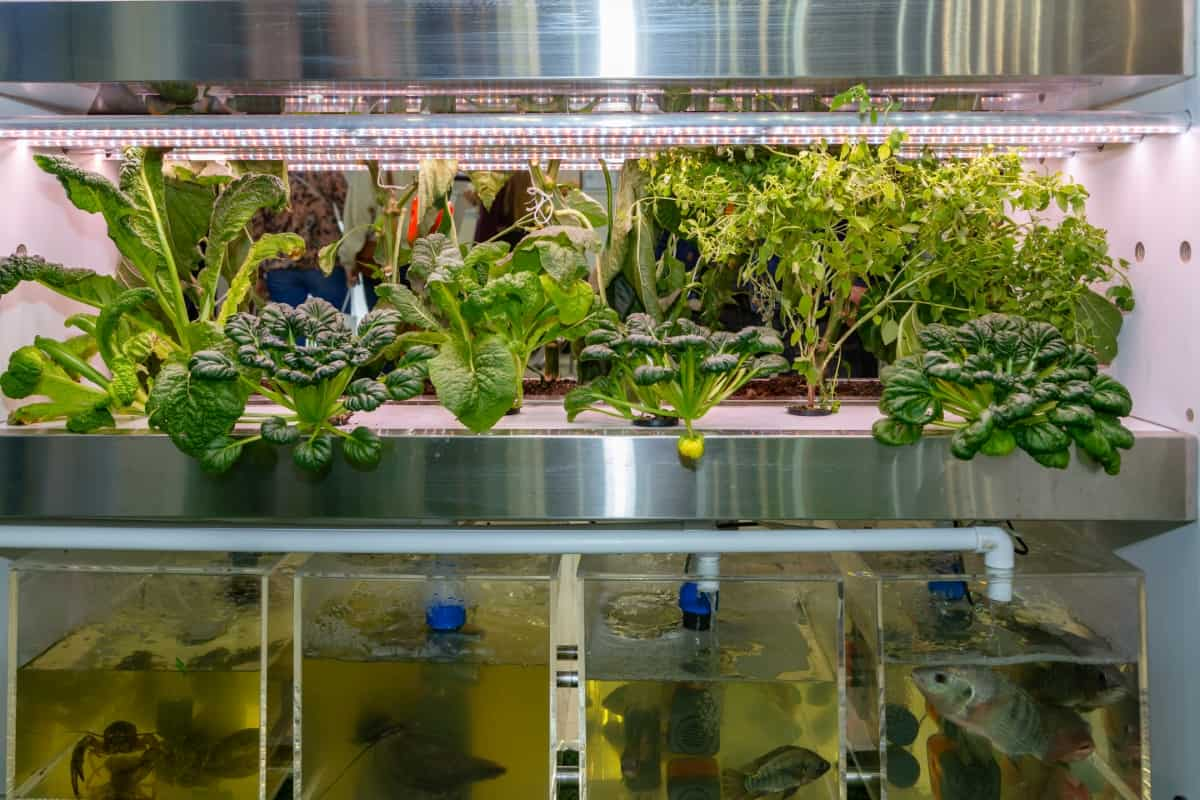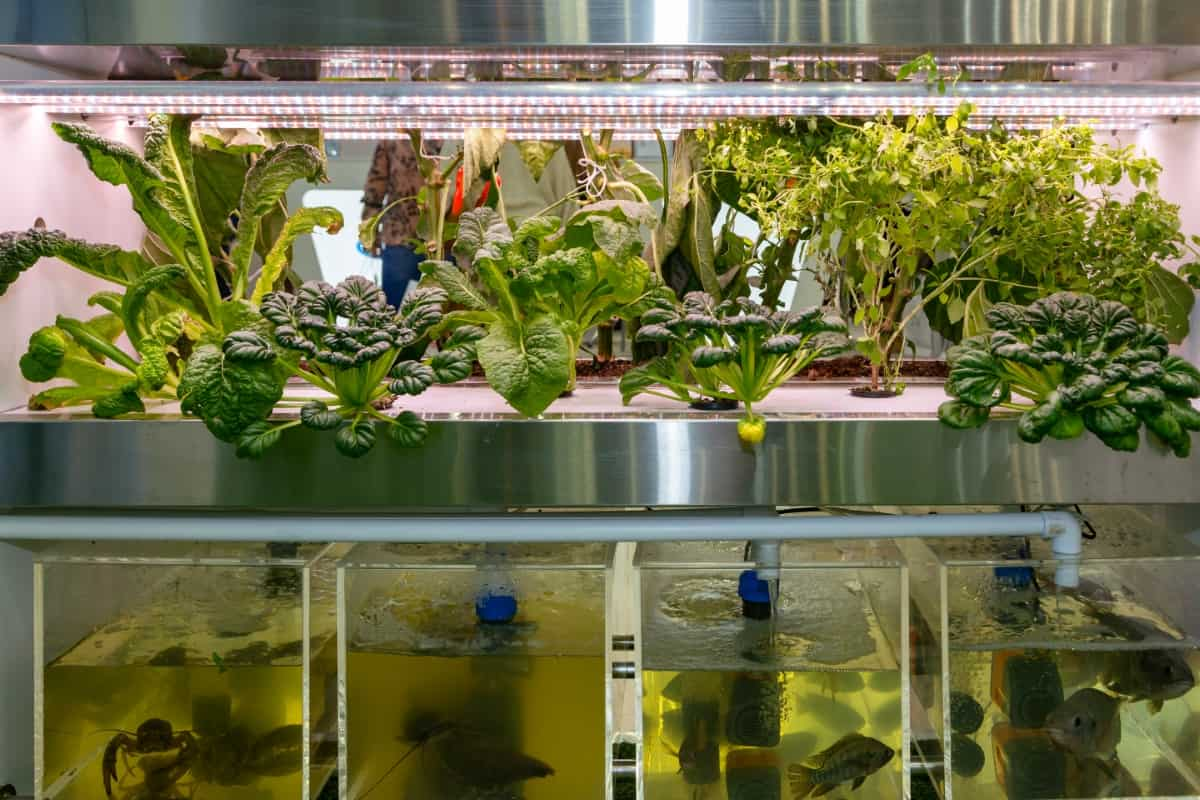Aquaponics in urban apartment gardening is a revolutionary and innovative way of growing plants and raising fish in limited spaces. It combines hydroponics, which involves growing plants without soil, with aquaculture, the practice of cultivating aquatic animals like fish. Urban apartment gardening has become increasingly popular in recent years as people seek to reconnect with nature and grow their fresh produce.

Aquaponics in Urban Apartment Gardening
Benefits of Aquaponics
Aquaponics in urban apartment gardening offers a multitude of benefits that make it an attractive option for those living in limited spaces. The main advantage is its ability to maximize food production while minimizing space requirements. With aquaponics, you can grow both vegetables and fish simultaneously, making efficient use of the available area.
Moreover, aquaponic systems are highly efficient and sustainable. Another benefit is the minimal water usage involved in aquaponics systems. Aquaponics promotes biodiversity within cities by providing habitats for various fish species while also supporting plant growth. Aquaponic systems are relatively low-maintenance once they are properly set up.
Setting up in An Urban Apartment
To start, you’ll need some basic equipment, such as a container or a fish tank, grow beds for plants, and a water pump. The first step is to set up the fish tank and ensure it is properly filtered and aerated. This will provide the necessary nutrients for your plants through their waste. Next, connect the grow beds to the fish tank using pipes or tubing. Fill them with a suitable growing medium like expanded clay pellets or gravel where your plants will take root.
Make sure there’s proper water flow from the fish tank into the grow beds so that plants can absorb nutrients. Now, it’s time to select appropriate plants and fish species for your setup. Choose leafy greens like lettuce or herbs that thrive in nutrient-rich environments. When it comes to fish, options like tilapia or carp are commonly used due to their fast growth rate and ability to tolerate varying conditions.
Maintaining an aquaponics system requires monitoring water quality parameters such as pH levels, temperature, ammonia content, and oxygen levels. By setting up an aquaponics system in your urban apartment, you not only have access to fresh organic produce year-round but also contribute towards reducing food miles while conserving water compared to traditional farming methods.
Choosing Suitable Plants and Fish Species
You want to select plants that thrive in a hydroponic environment. Leafy vegetable plants such as Lettuce, Kale, and Spinach are excellent choices as they grow well with the nutrient-rich water from the fish tank. Herbs such as basil, mint, and parsley can also be grown successfully in an aquaponics setup.
As for the fish selection, it’s important to choose species that can adapt well to confined spaces. Tilapia and trout are popular fish choices due to their ability to tolerate varying water conditions. However, if you prefer smaller tanks or have limited space available, you might consider species like goldfish or koi. Remember that maintaining proper balance is key when selecting both plants and fish for your aquaponics system.
Maintaining an Aquaponics System
Regularly monitor water quality: The health of your fish and plants depends on the water quality. Test the pH levels, ammonia levels, and nitrate levels regularly to ensure they are within the appropriate range.
Feed your fish appropriately: Overfeeding can lead to excess waste accumulation and poor water quality. Feed them only what they can consume within a few minutes.
Prune and harvest regularly: Trim any dead or decaying leaves from your plants to prevent disease spread. Harvest ripe fruits and vegetables promptly to encourage continuous growth.
Prevent pests and diseases: Inspect your plants regularly for signs of pests or diseases, such as aphids or fungal infections. Take necessary measures like using organic pest control methods if needed.
Clean filters periodically: Clean out debris from mechanical filters as well as solids removal tanks regularly to maintain proper filtration efficiency.
In case you missed it: Aquaponics Integration in Greenhouse Farming

Challenges and Solutions
The main challenge of practicing aquaponics in urban apartments is the limited space available. However, there are solutions to this problem. Vertical gardening systems can be used to maximize space utilization by growing plants upwards instead of outwards. Additionally, smaller fish tanks and compact grow beds can be utilized.
Another challenge is managing energy consumption in an urban apartment setting where electricity costs may be high. Opting for energy-efficient equipment such as LED lights and low-energy pumps can help reduce energy usage without compromising on plant growth or fish health. Maintaining optimal temperature levels for both plants and fish can be tricky in indoor environments with fluctuating temperatures throughout the year.
Installing a heating or cooling system alongside proper insulation measures can help regulate temperature variations within acceptable ranges. To control this issue, implementing preventative measures like regular inspection, using organic pest control methods such as neem oil sprays, or introducing beneficial insects like ladybugs into your garden could prove effective.
Integrating Aquaponics
One way to enhance the benefits of aquaponics in urban apartments is by integrating it with other urban agriculture techniques. For example, vertical gardening can be incorporated into an aquaponic setup, allowing plants to grow vertically on walls or trellises. This not only saves space but also creates a visually appealing green wall. Additionally, rooftop gardens can be combined with aquaponic systems, utilizing unused roof spaces for both fish and plant production.
The nutrient-rich water from the aquaponic system can be circulated through the rooftop garden beds, providing essential nutrients for plant growth while reducing water consumption. Composting is another technique that complements aquaponics well. Organic waste from garden trimmings and kitchen scraps can be composted and used as additional fertilizer for the plants in the aquaponic system. This closes the loop of nutrient cycling within the urban apartment ecosystem.
Educational and Community Aspects
By setting up an aquaponics system, individuals can learn about the interconnectedness of ecosystems and gain hands-on experience in cultivating plants and raising fish. This knowledge can be shared with others through workshops, seminars, or even by hosting open-house events where interested community members can observe and learn from the system.
In addition to education, urban aquaponics also has the potential to strengthen communities. The interactive nature of an aquaponic system encourages engagement not only within neighborhoods but also across different demographic groups within an urban area. Educational initiatives focused on urban aquaponics have the power to empower individuals with practical skills while fostering stronger bonds within communities.
By setting up a small-scale aquaponic system in apartments, individuals can gain firsthand experience in understanding the relationship between fish, plants, and bacteria. This hands-on approach allows for valuable lessons in biology, chemistry, and environmental science.
The Future
As our cities continue to grow and green spaces become increasingly scarce, finding innovative solutions for sustainable food production becomes imperative. In an urban environment where every square foot counts, this method allows us to maximize productivity using vertical growing systems and compact setups.
By utilizing vertical space effectively, we can create thriving gardens even in small apartments or balconies. Moreover, aquaponic systems act as natural filters by converting fish waste into nutrient-rich water for plants. This relationship eliminates the need for chemical fertilizers while promoting healthier growth and minimizing environmental impact.
In case you missed it: Aquaponics Vs Hydroponics: Key Similarities, Differences, and Yield Potential

Conclusion
Aquaponics is a sustainable farming that combines a hydroponics system (growing plants without soil) with aquaculture (raising fish). It’s a mutually beneficial relationship that results in both delicious vegetables and healthy fish. In this system, water from the fish tank is circulated to the plant beds, where the roots absorb nutrients from the waste produced by the fish. As a result, the water gets filtered naturally, and returns to the fish tank oxygenated.
- Feed Your Flock for Less: Top 10 Tips to Save on Chicken Feed
- Ultimate Guide to Ossabaw Island Hog: Breeding, Raising, Diet, and Care
- Hatching Answers: The Top 10 Reasons Your Chickens Aren’t Laying Eggs
- Eggs and Economics: Breaking Down the Cost of Raising Backyard Chickens
- Defend Your Greens: Proven Methods to Keep Iguanas Out of Your Garden
- Ultimate Guide to Cinnamon Queen Chicken: A Comprehensive Guide for Beginners
- Ultimate Guide to California Tan Chicken: Breeding, Raising, Diet, Egg-Production and Care
- Ultimate Guide to Marsh Daisy Chicken: Breeding, Raising, Diet, and Care
- 10 Types of Chicken Farming Businesses You Can Start for Profits